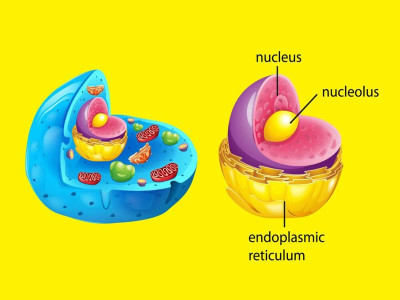Cooperative Study of Cell Organelles in Prokaryotes and Eukaryotes
Explore the cooperative roles of cell organelles in prokaryotes and eukaryotes. Discover their structure, functions, and significance in plant biochemistry to enhance your understanding of cellular mechanisms.

Cell organelles are specialized structures within cells that perform distinct functions vital for life. These organelles differ significantly between prokaryotes and eukaryotes, influencing their roles in various biological processes. This article explores cell organelles in prokaryotes and eukaryotes, highlighting their cooperative roles and their importance in plant biochemistry.
What Are Cell Organelles?
Cell organelles are functional units within cells responsible for processes like energy production, protein synthesis, and cellular maintenance. In prokaryotes, organelles are simpler and non-membrane-bound, whereas eukaryotic organelles are complex and enclosed by membranes. These differences reflect their evolutionary and functional diversity.
Prokaryotic Cell Organelles
Prokaryotic cells are unicellular organisms such as bacteria and archaea. They lack membrane-bound organelles but contain essential structures for survival and function.
Prokaryotic Organelles and Structures
1. Ribosomes
Prokaryotic ribosomes (70S) are smaller than those in eukaryotes but perform the same function: translating mRNA into proteins. These proteins are crucial for growth, repair, and enzymatic activities.
2. Nucleoid Region
The nucleoid is an unbounded region containing the circular DNA of prokaryotes. It serves as the control center for genetic activities, including replication and transcription.
3. Cell Wall and Plasma Membrane
- Cell Wall: Made of peptidoglycan, it offers structural support and protection.
- Plasma Membrane: Regulates material exchange and facilitates cellular signaling.
4. Additional Structures
- Flagella: Enable motility.
- Pili: Assist in adhesion and genetic exchange.
- Plasmids: Carry extra-chromosomal DNA, often conferring advantages like antibiotic resistance.
Eukaryotic Cell Organelles
Eukaryotic cells, found in plants, animals, fungi, and protists, are more advanced, containing membrane-bound organelles that compartmentalize cellular functions.
Eukaryotic Organelles and Their Functions
1. Nucleus
The nucleus is a double-membrane-bound organelle that houses DNA. It controls gene expression and cellular activities, acting as the “command center” of the cell.
2. Mitochondria
Known as the “powerhouse” of the cell, mitochondria generate ATP through cellular respiration, essential for energy-dependent processes.
3. Chloroplasts
Exclusive to plant cells, chloroplasts perform photosynthesis, converting sunlight into chemical energy and playing a pivotal role in plant biochemistry.
4. Endoplasmic Reticulum (ER)
- Rough ER: Studded with ribosomes; synthesizes proteins.
- Smooth ER: Involved in lipid synthesis and detoxification.
5. Golgi Apparatus
Modifies, sorts, and packages proteins and lipids for intracellular transport or secretion.
6. Lysosomes and Peroxisomes
- Lysosomes: Digest cellular waste and macromolecules.
- Peroxisomes: Break down toxic substances and aid in lipid metabolism.
7. Cytoskeleton
Provides structural support, facilitates intracellular transport, and maintains cell shape.
8. Vacuoles
In plant cells, vacuoles store nutrients, maintain turgor pressure, and manage waste.
Differences Between Prokaryotic and Eukaryotic Organelles
| Feature | Prokaryotes | Eukaryotes |
|---|---|---|
| Nucleus | Absent; nucleoid region | Present; double-membrane-bound |
| Ribosomes | Smaller (70S) | Larger (80S) |
| Organelles | Non-membrane-bound | Membrane-bound |
| Cell Wall Composition | Peptidoglycan (in bacteria) | Cellulose (plants) or chitin (fungi) |
| Examples | Bacteria, archaea | Plants, animals, fungi, protists |
The Role of Cell Organelles in Plant Biochemistry
Plant biochemistry relies heavily on the coordinated activities of cell organelles:
- Chloroplasts: Conduct photosynthesis, producing glucose and oxygen.
- Vacuoles: Regulate turgor pressure and store essential nutrients.
- Endoplasmic Reticulum: Synthesizes proteins and lipids required for plant growth and defense mechanisms.
- Mitochondria: Supply energy to fuel metabolic processes, including nutrient absorption and transport.
Cooperative Functions of Organelles
Cell organelles operate in a highly coordinated manner:
- The nucleus directs protein synthesis by providing mRNA, which ribosomes translate into proteins.
- The ER and Golgi apparatus ensure proper folding, modification, and transportation of proteins.
- Mitochondria and chloroplasts collaborate to balance energy needs and storage in plant cells.
- Lysosomes and vacuoles manage waste and maintain intracellular equilibrium.
Applications and Future Perspectives
Understanding the functions of cell organelles has led to advances in:
- Biotechnology: Leveraging organelles for crop improvement and biofuel production.
- Medicine: Developing treatments targeting organelle dysfunctions in diseases like cancer and neurodegeneration.
Future research promises insights into organelle interactions and potential applications in synthetic biology, sustainable agriculture, and personalized medicine.
Fun with “Cell Organelles Puns”
Exploring the lighter side of science, “cell organelles puns” can make learning engaging. For instance:
- Mitochondria: “Mitochondria is the powerhouse of the pun! 🏋️♂️”
- Nucleus: “Without you, I feel nuc-leus and out of control.”
- Golgi Apparatus: “I’m totally stacked like the Golgi apparatus!”
- Ribosome: “I’m just here making proteins and cracking jokes—ribosome style!”
- Endoplasmic Reticulum (ER): “ER you serious? Smooth moves, rough times!”
- Lysosome: “I’m breaking it down—Lysosome-style.”
- Cell Membrane: “I’m on the edge, but I’m keeping it selective like a cell membrane.”
- Cytoplasm: “I’m just trying to stay grounded in the cytoplasm of life.”
- Chloroplast: “You make me green with envy, just like chloroplasts in the sun!”
- Vacuole: “You’ve got a vacuole-lot of potential!”
- Cilia: “I’m moving with the flow, cilia you later!”
- Flagella: “Keep calm and flagella on!”
- Peroxisome: “Don’t be toxic, just be peroxi-some!”
- Centriole: “You’re the centri-role of my life.”
- Plasmid: “Stay extra—just like a plasmid!”
Puns like these help demystify complex topics, making cell biology accessible and fun for students and enthusiasts alike. Share these in your biology class or sprinkle them into science conversations for some laughs! 😄
Conclusion
The study of cell organelles in prokaryotes and eukaryotes highlights the complexity and adaptability of life at the cellular level. While prokaryotes rely on simpler structures, eukaryotes demonstrate intricate compartmentalization and interdependence. In plant biochemistry, these organelles drive essential processes like photosynthesis, nutrient storage, and energy production. Continued exploration of these fundamental units offers limitless potential for scientific discovery and innovation.
Cite this page:
- Posted by Dayyal Dg.